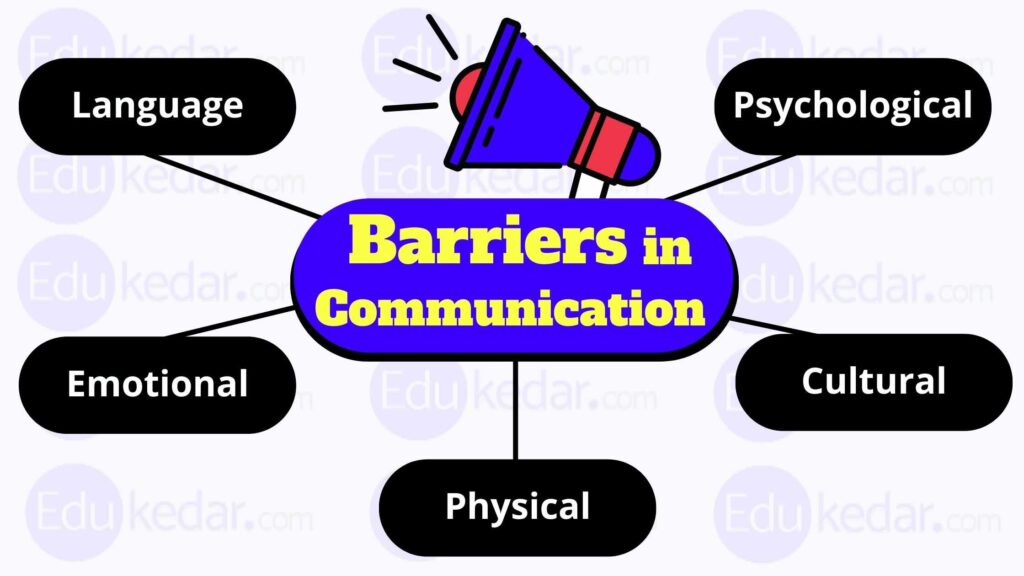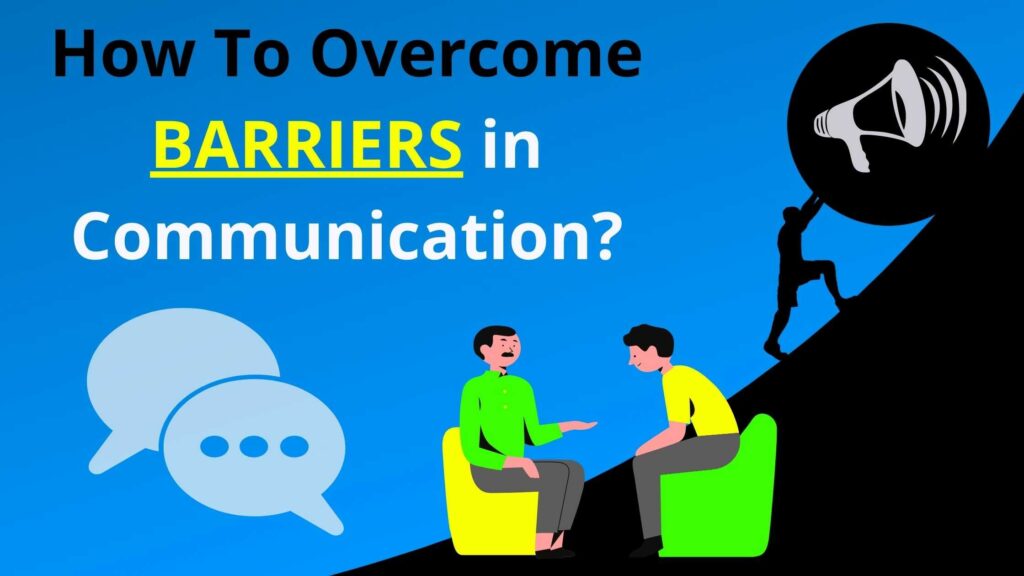In this article, we have shared 5 major barriers in effective communication explained with examples. We have also discussed ways to overcome these barriers with suitable examples. These barriers often hinder the process of communication and reduce the effectiveness of the communication.
The process of communication has multiple barriers based on the situation and ability of the person. The intended communication (information) will often be disturbed and distorted leading to a condition of misunderstanding and failure of communication.
Barriers in Effective Communication

Barriers in Effective Communication are simply obstacles in the communication process. The word barrier literally means an obstacle, a hindrance, or a problem that comes in a way of transmission of a message (flow of information) and blocks the communication process. Barriers can hinder the communication process either completely or partially.
Communication barriers make communication ineffective either in the form of delay, distortion, and incomplete information.
The Barriers to effective communication could be of many types and a few of them are as follows:
- Linguistic, (or Language and Semantic Barrier)
- Psychological,
- Emotional,
- Physical, (or Environmental Barrier)
- Cultural
► 1. Language Barriers:
Language Barriers is also known as Linguistic barrier and often called semantic barrier also. In this barrier, the language used by the sender may not be understood by the receiver.
Sometimes the two people involved in communication may speak the same language but the jargon (specific term) used to pass the information may break down the communication process if the receiver doesn’t fully understand it.
- The language barrier is one of the major barriers that limit effective communication.
- Language act as the most commonly employed tool of communication.
- Linguistic barriers occur due to the fact that each major region has its own language.
Example of Language Barrier in Communication:
- In many circumstances, even a thick dialect may render the communication ineffective.
- It is true that the dialects of every two regions change within a few kilometers. Even in the same organization, different employees will have different linguistic skills.
- Due to this variation in dialects, the communication channels that span across the company would be affected by this.
- Therefore, different considerations have to be made for different employees while communicating.
- In general, some of them are very proficient in a certain language and others will be ok with these languages.
► 2. Psychological Barriers:
The psychological state of a person (the receiver) will influence how the message is received. People with low self-esteem may be less assertive and it is obvious that may not feel comfortable while communicating. These people may feel shy and nervous about saying how they really feel or read negative sub-texts (context) into messages they hear.
- There are various psychological and mental issues that may be barriers to effective communication.
Example of Psychological Barrier in Communication:
- Many people have stage fear, speech disorders, lack of self-esteem, phobia, depression.
- All of these psychological traits and conditions are very difficult to manage sometimes and will most certainly act as barriers to communication.
► 3. Emotional Barriers in Communication:
Emotional barriers are a part of psychological barriers but it is more depends on the state of mind of the person. Feelings and emotions of communicators can hinder the delivery of information.
If the receiver is having any emotional or personal issues they are likely to be less attentive, which could lead to poor communication. The mental state and feeling of the sender and receiver influence how the message is received, perceived and sent.
- The emotional IQ of a person determines the level of comfort with which they can communicate.
- A mature person can handle emotions easily and will be able to communicate effectively. On the other hand, immature people and freshers who let their emotions take over will face certain difficulties.
- One should adopt a perfect mixture of emotions and facts to make communication effective.
Example of Emotional Barrier in Communication:
- It can be seen in many cases, Emotions like frustration, humor, fear, and anger can affect the decision-making capacities of a person and thus act as barriers to communication.
► 4. Physical Barriers:
Physical barriers are one of the most obvious barriers to effective communication. Physical separation and environment between the sender and receiver with combined faulty equipment are also considered Physical Barriers.
These barriers are mostly easily removable by eliminating the physical hindrance present in the channel of communication.
Example of Physical Barrier in Communication:
- Physical barriers include barriers like noise, closed doors, faulty equipment used for communication. Closed cabins and environment of a person, etc.
- It is often seen in a large office, the physical separation between various employees combined with faulty equipment may result in physical barriers to effective communication.
- Although modern technology and tools often serve to reduce the impact of physical barriers.
► 5. Cross-cultural barriers:
Cultural diversity within a country and cultural differences between people from different parts of the world are major causes of cultural barriers.
This is because people are conditioned by their cultures and traditions, and they develop certain habits of working, communicating, food habits, dressing, etc. according to their cultural conditioning.
It is obvious that they find it difficult to get through to people who come from an alien culture, and who have different habits.
- In times of globalization, all global companies and their large office may have people from several parts of the world.
- These different cultures have different meanings for several basic values of their society.
- Food habits, dressing, Religions, drinks, pets, and the general behavior will change drastically from one culture to another.
- Therefore, it is a must that we must take these different cultures into account while communicating.
- By taking this into consideration and accept this, it is called culturally appropriate.
- In many multinational companies (MNC’s), special courses are offered at the orientation programs that let people know about other cultures and how to be courteous and tolerant of others.
Example of Cultural Barrier in Communication:
- A simple thing like a greeting gesture of welcoming a person is very different in India from a greeting in an Arab country or in Japan.
- Food sources, recipes, and dress habits of a different culture can make a person uncomfortable.
- Concepts of personal space and time are also different across cultures. Indian people do not mind sitting close to each other and sharing space in offices or in public places. But in European countries, they would not be able to tolerate such intrusive behavior.
Must Read ➜ Steps in Planning Process
► How To Overcome Barriers in Communication?

Barriers can hamper the process of communication and can be harmful to business operations. Therefore, they must be resolved and overcome if communication has to be effective.
⦿ How To Overcome Physical Barriers?
- Physical barriers are comparatively easier to overcome because they can be identified easily.
- The use of loudspeakers and microphones of good quality can remove the barriers of noise and distance in crowded places like railway stations and in long queues.
- Automatic Traffic signals and non-verbal gestures of the traffic policeman remove physical barriers on the roads.
- Technological advancements especially software and machines have helped in reducing the communication gap arising due to time and distance.
- One should always make an alternative arrangement, to overcome the technological instruments’ fail.
- A backup plan and alternatives help in tidying over any problem and smooth the process of communication.
⦿ How To Overcome Language Barriers?
- Language or Semantic Barriers can be overcome if the sender and the receiver choose a language that both of them understand very well.
- In case of no knowledge of the language, the sender can take help from a translator or an interpreter to overcome the language barrier.
- training and development programs to get exposure to the target language helps in overcoming the language barrier.
- Language barriers can be avoided by self-study through online translators and accurate use of language.
- A clear meaningful flow of information should be the main objective when using language.
- Jargon should be avoided in the case of the regional and rural workplace.
⦿ How To Overcome Psychological, Emotional, and Cultural Barriers?
Psychological barriers, Emotional barriers, and cross-cultural barriers are difficult to overcome. These barriers are difficult to identify and even more difficult to address.
- All these barriers can be avoided or reduced by adopting a flexible and open-minded attitude towards others.
- The ultimate aim should be to build bridges of understanding between people while communicating.
- One should train himself to listen to different views, exposing oneself to different environments help in broadening one’s outlook and cultivating tolerance to multiple views.
- Increase empathy while communicating can helps in making oneself more open to others.
There are various things that need to be taken care of while dealing with psychological or cross-cultural barriers.
The sender should always make it a point to –
- Use language that is politically neutral and correct.
- Present views in a simple and objective manner.
- Focus on the objective of communication.





